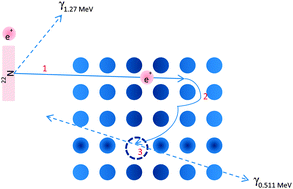Application of positron annihilation lifetime spectroscopy (PALS) to study the nanostructure in amphiphile self-assembly materials: phytantriol cubosomes and hexosomes†
Abstract
Self-assembled amphiphile nanostructures of colloidal dimensions such as cubosomes and hexosomes are of interest as delivery vectors in pharmaceutical and nanomedicine applications. Translation would be assisted through a better of understanding of the effects of drug loading on the internal nanostructure, and the relationship between this nanostructure and drug release profile. Positron annihilation lifetime spectroscopy (PALS) is sensitive to local microviscosity and is used as an in situ molecular probe to examine the Q2 (cubosome) → H2 (hexosome) → L2 phase transitions of the pharmaceutically relevant phytantriol–water system in the presence of a model hydrophobic drug, vitamin E acetate (VitEA). It is shown that the ortho-positronium lifetime (τ) is sensitive to molecular packing and mobility and this has been correlated with the rheological properties of individual lyotropic liquid crystalline mesophases. Characteristic PALS lifetimes for L2 (τ4 ∼ 4 ns) ∼ H2 (τ4 ∼ 4 ns) > Q2 Pn3m (τ4 ∼ 2.2 ns) are observed for the phytantriol–water system, with the addition of VitEA yielding a gradual increase in τ from τ ∼ 2.2 ns for cubosomes to τ ∼ 3.5 ns for hexosomes. The dynamic chain packing at higher temperatures and in the L2 and H2 phases is qualitatively less “viscous”, consistent with rheological measurements. This information offers increased understanding of the relationship between internal nanostructure and species permeability.


 Please wait while we load your content...
Please wait while we load your content...